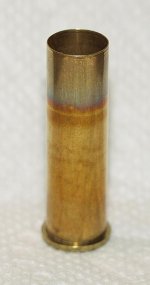No need to get the brass to red heat, though that will certainly soften the brass. Maybe too much especially if you are forming a case.
You can get collapsed necks telescoping into the case instead of simply reforming or resizing as the brass is so soft it can't support itself in the operation.
A lead pot already mentioned was a popular way to anneal case necks at one time. Molten lead is only around 600F+. and it does the job nicely. Certainly 'red hot' brass in a propane flame isn't needed.
To relieve the brittleness and work hardening from repeated reloadings or case forming operations, I've always just handled each case by the base of it with my finger tips.
Roll the case so the neck only is just above the intense portion of the flame of a propane torch.
I do a 1,2,3,4 count as I roll the case and then just place them on the concrete floor of the basement where I'm working.
Placing them on a steel bench or other metal surface to draw the heat away will do as well.
That cools them quick enough and the heat never reaches by fingers or the body or base of the case.
If the case gets too hot to hold doing it this way,,you're holding it in the flame way too long.
No water pan to deal with, no wet cases to dry out afterwards, no gadgets to hold each case as it's annealed, no lead pot.
Fast and clean.
I don't anneal pistol cases anyway but I wouldn't use this method with the shortys!
I admit I don't do thousands of cases at a time, but I do sometimes anneal 50 to 100 at a time and do those with no problem or fatigue.
If I was running thru and reloading for an AR or some similar type of firearm that ate thousands of rounds and required annealing of same,,then one of the mechanical set-ups I've seen would probably be the answer.
Either that or just buy the ammo and sell the emptys.




